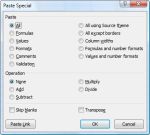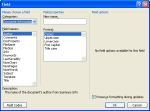 |
Hints Tips & Rants
by Dale Atchison Tampa Bay Computer Society |
I swear, I feel like I'm talking to a wall most of the time. I've been telling my clients and my readers for years to stop using Microsoft's Internet Explorer Web browser. Yeah, I know it's the most popular browser, and for two reasons:
|
Have you been bitten by the fake Microsoft Security Center yet? If you haven't, and you're using IE, you will be eventually: You get a popup message, saying your computer is infected, and offering to download the software to fix it. At this point, it doesn't matter what you do: you're already infected! The worst thing you can do is click on the button to download the software, but all possible choices are bad ones, in that nothing you do at this point will remove the infection... because it's not really an infection at all, it's an ActiveX control, and you already gave it permission to load, or you'd never have seen the popup warning in the first place. I have managed to remove it using System Restore, but I've also failed to remove it using the same utility.
Here's a better idea: Reboot into Safe Mode, open Control Panel » Internet Options » Programs » Manage Add-Ons. Choose "All Add-Ons" on the left, and go down the list on the right, looking for any add-on that doesn't have a publisher name you recognize, or that says, "not verified" before a publisher's name, even if you do recognize it. Highlight each of these suspicious add-ons in turn, and click the Disable button, lower-right. When you finish, click on Close.
Once you've repaired IE hopefully, that's what you just did you need to download and install Google Chrome (www.google.com/chrome) or Apple's Safari web browser (www.apple.com/safari).
And let that be the last time you ever use Internet Explorer: open Control Panel » Add or Remove Programs » Add/Remove Windows Components. (I started to include specific wording for fixing the problem in Windows Vista and "7", then realized I haven't seen it in those OS'es yet, only XP; I wonder...?) When the "Windows Components" window pops up, remove the check mark next to Internet Explorer, and click Next. Click Finish when the process completes, then reboot. You can't actually remove Internet Explorer, Microsoft has rigged it so that would break Windows; but you've at least made it harder to find and run.
After mentioning the fake Security Center last month, I received an email from a reader, suggesting I try WinPatrol to see if it could protect from the malware in question. Great minds think alike: I've used and distributed WinPatrol for at least six years; I push it on all my clients, as well. But it has the same problem IE has: it stops and asks. If you don't know any better, you can still give permission for malware to load.
Sad to say, but any program so restrictive as to completely protect you from yourself will keep you from having full enjoyment of your computer. You have to stop and think when offered ANY change to your PC, and ultimately take resposibility for deciding what to accept and what to reject. That's only my opinion, but this is my column, so it all kinda works out: if you want someone else's opinion, go read their column. I'll wait for you right here.
And if you just don't know what to do when offered a new startup program, etc., call me: 727 687-0842. I'll ask a question or two, then tell you Yea or Nay, for free. Don't toss in any other problems while you're bending my ear I only do phone support for a few of my very best clients, and I won't be polite about it. But I will answer the Yea or Nay questions WinPatrol asks (maybe not so much IE, as I just told you to quit using it).
Tips.Net
Microsoft Excel Tip: Quickly Updating Values
Many people use Microsoft Excel to keep track of important information, such as price sheets or cost tables. This data is then used to help calculate proposals, or to figure out how much should be charged to customers. It is not uncommon to need to update information in these tables on a periodic basis. For instance, your company may decide that it will increase all prices in the company by ten percent this year.
If you have rather large pricing tables, you may not know the best way to update the prices by the ten percent. Obviously, you could make a secondary table, and then base the information in that table on a formula, such as =B3 * 1.1 . This is actually more work than is necessary, however. Excel provides a much quicker way to update values in a table by a uniform amount. Simply follow these steps:
Copyright © 2009 by Sharon Parq Associates, Inc. Reprinted by permission. It is not unusual to put a page number in your headers or footers, if you choose to use headers and footers with your document. You can also, however, insert a field that indicates the total number of pages in a document. This can be used in a header or footer, or directly within the text of your document. To insert the total number of pages in your document, follow these steps if you are using a version of Word prior to Word 2007:
If you are using Excel 2007, then the steps are slightly different:

The Paste Special dialog box.
That's it! All the values in your pricing table now show a ten percent increase from their previous values.

The Paste Special dialog box, 2007-style.
Thousands of free Microsoft Excel tips can be found online at excel.tips.net
Microsoft Word Tip: Inserting the Total Number of Pages in Your Document
The process of inserting a field is a bit different in Word 2007. Follow these steps:

The Field dialog box.

The Field dialog box, 2007-style.
Thousands of free Microsoft Word tips can be found online at word.tips.net .
Monthly Maintenance Update
I updated my nearly-famous Monthly Maintenance routine in February; maybe you saw it? Almost immediately, Phil Del Greco wrote and told me how much he prefers Piriform's CCleaner to EasyCleaner, and Piriform's Defraggler to IOBits' Smart Defrag. I tried them...
Next month, I'll be replacing EasyCleaner in my Monthly Maintenance routine, and publishing instructions on how to set it up just once so it does everything you need automatically from then on. I'm still testing Defraggler to see if I prefer it to Smart Defrag; it seems to take twice as long to do a thorough defrag, but so far I can't tell if the results are worth the wait. But I'll know before the May issue goes up.
Till next month...
|
DaLe aTchiSon DaLe@ComputerRepairShop.biz
|





